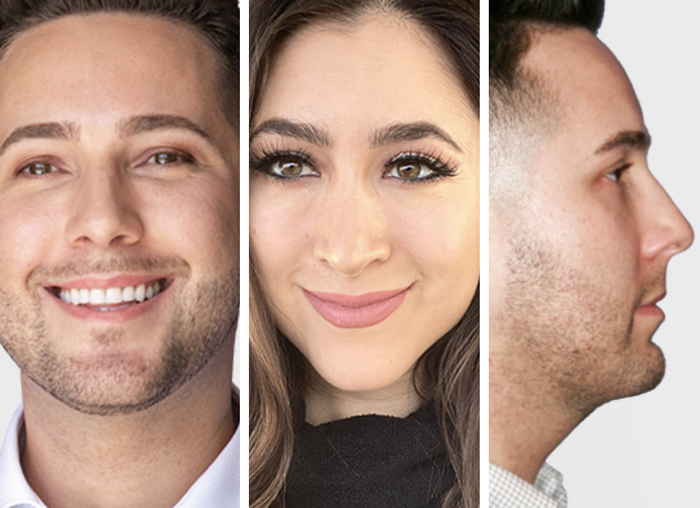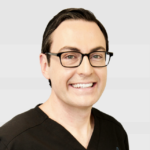As the face ages, the effects of a constant force of gravity are coupled with changes in the skin and connective tissue, as well as a loss of fat (adipose tissue). The earliest changes occur in the area around the eyes (periorbital region) and the midface (the part of the face between the eyes and the mouth). The youthful convexity (fullness, or round appearance) of the midface decreases as the malar fat pad descends. This has two major effects: first, and most obvious in younger patients, is the appearance of tired, hollow, or sunken eyes; second, and often a little later, is the development of visible nasolabial folds – even at rest. The most distressing part of these changes is that patients do not feel as old as they look – they have great energy and passion, but are often asked if they’re tired or not getting enough rest. Shadows around the eyes, or a subtle shift in the weight of the face from the upper cheeks to the lower face, are visual signs of age. And the unfortunate truth is that we live in an “age-ist” society.
Dr. Ransom can address these specific concerns with a variety of techniques, and is proud to be the one of a select few surgeons in the Bay Area offering a minimally-invasive endoscopic facelift (also known as the extended centrolateral, transtemporal midface lift). Rhytidectomy, also known as “facelift” or “face-lift” is a surgical procedure designed to release and reposition the soft tissues of the face, and, in many cases, to remove excess skin and fat. With a minimally-invasive midface lift, all of the incisions are placed behind the hairline – so that they leave no visible scars! Dr. Ransom uses these hidden access points to lift the soft tissues of the midface, returning them to a more youthful position and giving a natural-appearing rejuvenation.
Explore our
Patient Gallery
*Actual patients in photos

Who is a candidate?
Candidates for a midface lift (endoscopic facelift) include all patients with a drooping or hollow-appearing midface, and the early signs of jowls and loose or sagging skin in the lower face. The term facelift (or face-lift) can be used by doctors and in the media to imply a wide variety of procedures and approaches. Dr. Ransom uses the midface lift (endoscopic facelift) for select candidates with primary aesthetic concerns in the middle and upper thirds of the face. This approach is minimally-invasive, using small incisions placed behind the hairline. As such, it is not appropriate for patients with significant skin excess or heavy neck tissues. These patients are better served with a mini-facelift or facelift. As a final note, the midface lift using a predominantly vertical vector, which helps Dr. Ransom’s patients look natural, avoiding the “wind-swept” or “pulled” look.
Frequently Asked Questions
Please note that all patients are different and individual healing times and results may vary. The statements regarding procedures and recovery made here are general rules.
For most patients, a week off of work is sufficient. Bruising and swelling will occur immediately after the surgery, and begin to resolve around the third day. The majority of this process occurs in the first week. Pain is very minimal. Dr. Ransom works closely with you throughout the postoperative period, making sure that you are making progress toward an excellent result. Further details can be discussed with Dr. Ransom during your confidential consultation.
Yes. Though Dr. Ransom would strongly advise you to quit smoking to improve your overall health, smokers can undergo endoscopic facelifts. With the endoscopic technique, the plane of surgical dissection is deep to the blood supply of the facial soft tissues. As such, problems with blood flow that are associated with tobacco use are avoided. This is because the blood supply to the face is preserved in this approach, and better blood supply means better healing. As a side note, Dr. Ransom has a keen interest in helping patients try to quit smoking (tobacco cessation), and has even performed clinical research in this area. He would be happy to discuss this with you during your consultation, and he is able to prescribe medications to help you quit before surgery.
Dr. Evan Ransom is an Ivy League-educated and Ivy League trained Facial Plastic and Reconstructive Surgeon. He is a Double Board Certified Head and Neck Surgeon and Facial Plastic and Reconstructive Surgery and fellowship-trained in facial plastic, reconstructive, and laser surgery. His practice is in the San Francisco Bay Area, serving patients from San Francisco, Oakland, Marin County, Palo Alto, Silicon Valley, Walnut Creek, the East Bay, and all over Northern California.
 (415) 550-1077
(415) 550-1077 San Francisco
San Francisco




